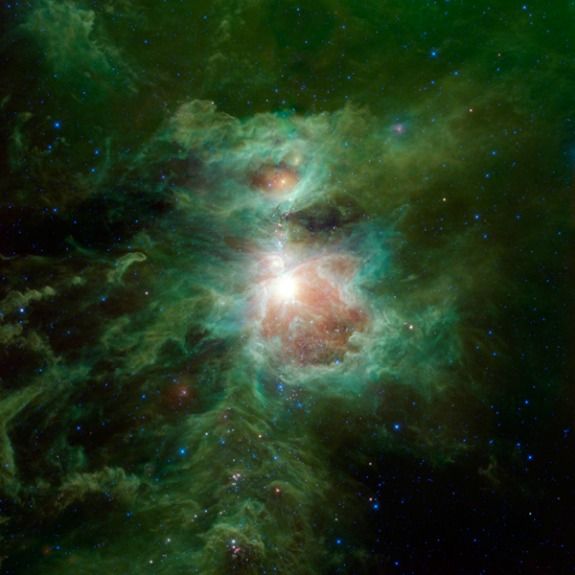New Photos Show Stars on the Brink of Death and the Precipice of Life
Haunting images of spiral galaxy M106 and the stellar nursery of the Orion nebula capture the life cycle of stars
/https://tf-cmsv2-smithsonianmag-media.s3.amazonaws.com/filer/Surprising-Science-Stars-631.jpg)
Space added several stunning new images to its photo album this week, including the one above of spiral galaxy M106, located 23.5 million light-years away in the constellation Canes Venatici, Notice something?
The image, released yesterday, actually contains two spirals overlain on each other. One is the cloudy, blue-white spiral with a yellow core. The core itself is a composite of images take by the Hubble Space Telescope‘s Advanced Camera for Surveys, Wide Field Camera 3, and Wide Field Planetary Camera 2 detectors. Spiraling outward, the cloudy arms also come from Hubble, but were colorized with ground-based images captured from relatively small telescopes (12.5-inch and 20-inch) as they imaged from dark, remote sites in New Mexico. The telescopes, owned by photo-astronomers Robert Gendler and R. Jay GaBany, helped these astronomy enthusiasts fill in gaps left by Hubble’s cameras. The images were meticulously assembled into a mosaic by Gendler, a physician by training, to form the base spiral of the photo illustration above.
But what about the second spiral? Emanating at odd angles is a glowing red swirl, known as the “anomalous arms” of M106, These arms, captured by Hubble imagery and GaBany’s telescope, are enormous streamers of irradiated hydrogen gas molecules which glow red when seen through special filters. This begs the question–what’s cooking the hydrogen?
The answer is…a black hole! As astronomer Phil Plait blogs in Slate, “Every big galaxy has a supermassive black hole in its core. The Milky Way has one, and it has about 4 million times the mass of the Sun. The black hole at M106’s heart is about 30 million times the mass of our Sun. Besides being heftier it’s also actively feeding, gobbling down material swirling around it (our own galaxy’s black hole is quiescent; that is, not eating anything at the moment).”
While this photo shows stars at the brink of death within M106, another photo released yesterday shows the environment of stars at their birth:

Tinged an eerie green–like smoke from a witch’s brew–the new image from NASA’s Wide-field Infrared Survey Explorer (WISE) was taken after zooming in on bright dot in the “sword” of the constellation Orion. Visible to the naked eye as a single fuzzy star (also known as M42), the dot is actually a cluster of stars, surrounded by the Orion nebula. Here, stars are born.
The image captures the infrared nimbus formed as newborn stars are compressed from vast clouds of gas and heat the wisps that remain. White regions are the hottest part of these stars’ first dust bath, while greens and reds show lukewarm dust. Carving holes through the dust are massive stars–newly formed–such as the one seen at the picture’s center.
The Orion nebula is a site of star formation close to the Earth, giving scientists the opportunity to study its characteristics and hypothesize on how our Sun was born five billion years ago, perhaps from a similar cloud of dust. The white orbs seen here are less than 10 million years old.
The images of the death and birth of stars–both hauntingly beautiful–showcase the evolving nature of space. Mirrored by our own cycles of life and death, the pictures help to link our daily grind with the vastness beyond Earth.
/https://tf-cmsv2-smithsonianmag-media.s3.amazonaws.com/accounts/headshot/mohi-kumar-240.jpg)
/https://tf-cmsv2-smithsonianmag-media.s3.amazonaws.com/accounts/headshot/mohi-kumar-240.jpg)